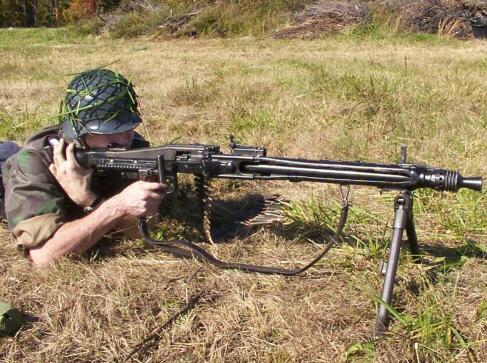WW2Steel.com
page last modified 04Feb'21
MG42:

History:
The MG42 appeared in 1941 to supplement the MG34,
though not totally replace it. The MG42 was easier and faster to
build than the MG34, with a substantial increase in rate of fire. The
MG42, due to its looser design parameters, could ingest higher volumes
of foreign debris and continue to function. Jamming was not a
particular problem for the MG34 though. The bolt was greatly
simplified from an intricate twisting locking mechanism to a much more simple dual roller lock which both locked it
to the barrel momentarily upon firing and held the firing pin retracted
until the bolt was fully seated in the barrel. Though the barrel
removal is interesting on the MG34, it is faster on the '42, reducing
time (in my experience) from roughly 7 seconds to 5. Due to the reduced manufacturing tolerances in some parts of the MG42, and the recoil
effect of the higher rate of fire, the accuracy was somewhat
reduced. Keep in mind that the function of a machinegun of this type is firing on large targets such as groups of troops or vehicles, and suppression. The MG42 was superior to the MG34 in both respects. The psychological effect of the rate of fire (for both sides) was significant. The MG34 was a beautiful display of pre-war
arms manufacture capability; the MG42 was a wartime functional replacement. Imagine the U.S. in a big war... it's doubtful we'd mass produce F-22s for
long.
In short... The
MG42 could be made faster and more easily by less trained (or forced)
labor. It jammed slightly less per round (but more often over
seconds of firing duration- especially with later steel cased
ammo). The barrel swap is improved, but this feature prevents most armored vehicle use. It was less accurate, but projectile density over area
remained similar (more rounds, but over a larger area). The MG34 remained in service until the end of the war and
as the nearly exclusive internal armored vehicle armament in the modified panzer
derivative.
The MG42 is still in service today as the MG3 (among several
others), chambered for NATO 7.62.
|
Country of Origin: |
|
|
Caliber: |
7.92 * 57 Mauser |
|
Weight: |
25.35lb (11.5kg) |
|
Feed/ Capacity: |
50 round belt - linkable up to 250 rounds = 1 box (per manual, they can be linked as long as you like). |
|
Rate of Fire: |
1200 rpm |
|
Muzzle Velocity: |
2650fps (800mps) |
|
Range: |
10,000' (3000m) + (on tripod) |
Gas Simulators:
This is known in reenacting circles as a 'gas gun'. For those not
familiar with the term it denotes a unit which mixes a fuel such as
propane and oxygen into a combustion chamber. A small computer opens
and closes the gas solenoids and times an ignition circuit which fires
a spark plug inside the chamber. This type of simulator is safer than
blanks, as no burning powder is expelled. NOTHING CAN BE LOADED INTO
THE CHAMBER OR EXPELLED FROM THIS UNIT. This makes it perfect for
reenactments, living history displays, and movies. I no
longer build gas simulators as it is very time intensive and they can
be quite temperamental. I do offer a small manual that helps with the construction
of one for $15. This manual is explained and available here.
(Still part of my website.)
To make something clear... I enjoy the study of German equipment because it was cutting edge technology (though not always practical).
I do not support the intense evil of many of the totalitarian dictatorships involved in the conflict (on both sides). I proudly remember the efforts of millions of heroic soldiers and civilians from around the world, those that fought with dignity!